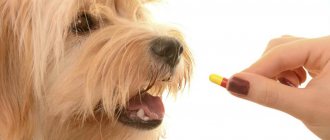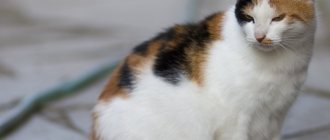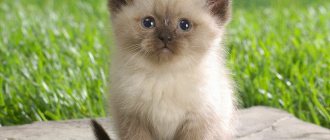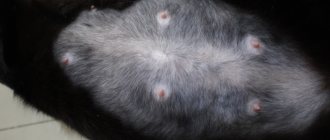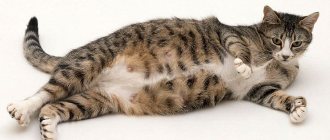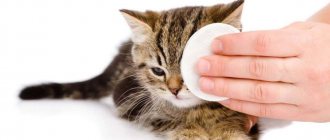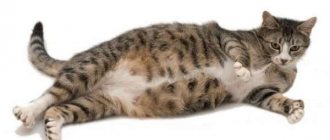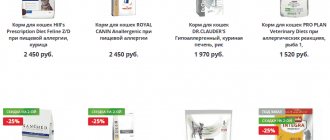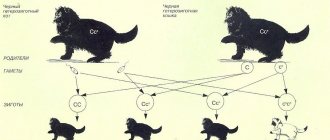Cats during pregnancy and lactation are most vulnerable to various types of inflammatory processes and infections. Among complications during childbirth, one of the main ones is mastitis, which is an inflammatory process that develops in the mammary gland of a cat.
In order to begin treatment in a timely manner, it is necessary to know the main symptoms and causes of a tumor in the mammary gland in a nursing cat, which will allow you to provide assistance to the animal and avoid dangerous consequences.
It is important to know that a tumor in the mammary gland can be lactostasis, which also leads to the development of mastitis. Delayed assistance can lead to complications and in some cases can cause death. This is due to a general decrease in the cat’s body’s defenses during pregnancy and childbirth, as well as the onset of lactation.
It is not advisable to self-medicate and delay a visit to the veterinarian.
The most common causes of mastitis
- diseases of the genital area during or after pregnancy;
- hormonal disruptions during “empty” estrus (during which fertilization does not occur) and false pregnancy;
- stagnation of milk in the mammary glands due to its excess, mastitis after early weaning of kittens (congestive inflammatory process);
- mechanical bruises or injuries;
- bacteriological or fungal infection through cracks or any other nipple injuries (septic process);
- general hypothermia or directly mammary glands in a nursing cat;
- complications during the postpartum period (for example, purulent endometritis or pyometra) or after sterilization (in sterilized individuals, infection occurs due to complications in the postoperative wound).
The cat’s mammary glands are swollen after giving away the kittens, what should I do?
The birth of kittens is almost as important an event in the home as the birth of a human child. Cats are very good mothers and the removal of kittens is almost always stressful for them. The optimal time for babies to be taken away from their mother is one and a half months. At this age, kittens can already eat on their own. However, babies need their mother until about four months of age.
Main signs of mastitis
- enlargement of the mammary glands (all, in pairs or separately in lobes);
- increase in local or general temperature (with prolonged flow);
- soreness when touched;
- redness around the nipples;
- discharge from the nipples of varying consistency (in the form of cottage cheese, kefir consistency or an admixture of blood, pus, fibrin);
- lethargy and deterioration of general condition, preventing kittens from feeding.
There is a form of subclinical mastitis in cats, the signs of which are either weak or not manifested at all (asymptomatic). Only an attentive owner can understand that something is wrong with his health:
- the animal shows slight anxiety during feeding, and between them almost constantly licks the diseased lobes of the lactating gland;
- kittens become more restless due to underfeeding or stomach upset, because... with any form of mastitis, milk from the affected lobes changes its properties;
- There is no obvious soreness, no increased temperature or redness around the nipples.
With such signs, it is important to take your furry pet to the veterinarian to rule out other, more dangerous diseases that are practically asymptomatic.
According to the nature of the course, mastitis is classified into:
- catarrhal;
- serous;
- fibrinous;
- purulent;
- hemorrhagic;
- abscessing.
Very often the forms transform into each other due to incorrect and/or untimely treatment or coexist simultaneously.
Kittens were given away and the cat's milk comes in, what should I do?
The kittens were taken from the cat
The cat shows concern, is looking for babies, and is worried. What to do? What actions to take if a cat is looking for her kittens?
Try to give the animal more attention and affection. For the future, it should be taken into account that the optimal age for kittens to separate from their mother is 2.5 months. Both the cat and the children will be psychologically ready for separation, and the mammary glands will be ready for natural involution. To minimize the stress of separation from kittens:
You can arrange another cozy nest for your cat, a refuge, or buy a new toy if she is playful. Eliminate additional stress factors, such as contact with strangers, noise, or the departure of the owners.
Medical assistance on time
The behavior and condition of a pet left without kittens will not go unnoticed. The cat lets out a plaintive meow, rushes about, and tries to take a tastier piece to various “hiding places.” Breast engorgement and loss of appetite are also possible. Don't underestimate this condition. A timely visit to the veterinarian will most likely result in the prescription of sedatives, and may possibly prevent more serious problems in the future.
It happens that a cat that has given birth a long time ago behaves just like a new mother. First of all, you need to make sure that your pet does not have a hormonal disorder. Taking samples and examining a veterinarian will help make a diagnosis. If future plans do not involve breeding kittens, it is more humane to sterilize the animal, in the absence of contraindications, so as not to put stress on its reproductive system and nerves.
If there's a problem
If a disaster occurs: the cat’s birth ends unfavorably, the body informs the animal’s brain that she was about to give birth to kittens. Having taken care of the absence of postpartum complications, do not forget about the psyche of the animal that has experienced a severe shock.
Source
Treatment of breast inflammation
What are the consequences of improper treatment of mastitis?
It should be noted that self-help for mastitis in cats at home is only permissible in the initial stages, when the process has not started and a secondary infection has not occurred. In other cases, a visit to the veterinarian and compliance with all medical prescriptions is required in order to effectively cure mastitis in a cat.
The consequences of the inflammatory process are:
- degeneration of the mammary glands with the formation of tumors, both benign and malignant;
- death of the animal from general intoxication and sepsis;
- death of kittens from poisoning with contaminated milk.
What if the cat didn't give birth?
Mastitis in nulliparous cats is a clear reason to visit the veterinary clinic. Problems in the mammary gland after childbirth have a classic cause (milk stagnation, infection through the nipples) and a logical consequence (inflammatory process), which are obvious even to a non-specialist. Inflammation without the presence of milk production is always some other serious reason (hormonal imbalances, injuries, internal diseases, etc.), which only a specialist can accurately determine.
What to do with the offspring during the treatment period?
A cat has mastitis - what to do with kittens? Usually they are removed during treatment, not allowing them to feed on contaminated milk. If not all parts of the mammary gland are involved in inflammation, you can try to isolate (bandage or seal) the nipples of the diseased lobes, and leave access to the healthy ones. Milk with purulent mastitis is contaminated, there is a high risk of not only indigestion in newborns, but also fatal poisoning.
When can you provide help without a veterinarian?
You can try to provide assistance yourself - treat mastitis in a cat at home - only with a serous or catarrhal form. In all other cases, therapy should only be carried out by a veterinary specialist. Moreover, the average animal owner cannot always distinguish between different forms of damage (even looking at the photo).
What to do if the cat has milk left, but no kittens?
Many owners of unsterilized animals (both purebred and domestic animals) are concerned about the question of whether the pet that has given birth needs any special care. Let’s say if a cat lost her kittens, or they were given away, what should we do with the milk that the cat has left?
If there are no kittens and lactation has not yet ended, a number of measures may need to be taken to ensure that this natural process is completed without harm to the cat’s health.
Expressing milk from a cat at home
You won’t be able to express milk by hand the way cows do it! All attempts to manually remove milk will only lead to unnecessary pain to the animal and additional injury to the mammary gland!
To express milk, use something like a breast pump, made from a disposable syringe with a volume of 5 ml (preferably with a rubber piston). The piston is removed, and the top of the syringe is cut off along with the nose on which the needle is placed. The edges of the cut are carefully burned over a gas burner or lighter, using your fingers to even out the circle (after it has cooled slightly). The piston returns. Now, by pressing this product tightly against the skin around the nipple and gently pulling the piston, a vacuum is created, and the milk is gradually expressed (if the ducts are not completely blocked).
Prevention of mastitis
Systematic examination of the mammary glands will help reduce the risk of developing inflammation of the mammary glands in cats. Owners must create optimal living conditions for their pets, maintain immunity, and prevent the cat from hypothermia and contact with stray and homeless animals. Take care of your pet’s hygiene, change the tray in a timely manner, and treat it against ecto- and endoparasites.
If the cat is kept on a natural diet, do not forget to give mineral supplements and vitamin complexes to increase the body’s resistance. Do not neglect preventive revaccinations to prevent the development of viral, infectious, and parasitic diseases.
If you notice wounds, cracks, or dry skin in the nipple area, treat the damaged areas with special products and antibacterial solutions.
In order not to wonder why mastitis occurs in a cat, or how to treat your pet, you need to take all possible measures to ensure that the furry beauty avoids the disease.
If you do not plan to breed kittens, then it is better to immediately sterilize the animal rather than treat the kitty with hormonal drugs for estrus.
If only one or two kittens are born, you need to slightly limit the liquid the cat drinks so that excessive milk production does not occur, and the kittens can suck the milk completely. Babies need to periodically trim their claws so that they do not injure their mother’s breasts when feeding. The place where the mother and kittens are must always be clean, the bedding is changed as the slightest contamination occurs. The cat's litter box also needs periodic disinfection.
Hypothermia should not be allowed for a nursing mother to prevent any colds or inflammations from occurring.
Timely implementation of preventive measures will help prevent the development of the disease and protect your pet from unpleasant symptoms.
Prevention methods for mastitis:
- Timely vaccination.
- Treatment of animal fur with antiparasitic agents. Since fleas cause severe itching, the cat can injure the mammary glands in the process of scratching, which contributes to the development of bacteria and infections.
- Selecting the right diet for a nursing cat, which does not contain products that affect the increase in milk supply.
- Providing the cat with satisfactory living conditions, a clean potty and bedding.
- Minimizing the risk of hypothermia or injury to the cat.
- Treatment of wounds and cracks on the nipples with a solution of potassium permanganate.
- Regular cat examinations.
- Expressing if kittens do not drink all the milk.
If you take care of your pet’s hygiene, diet, and regularly conduct examinations at the veterinarian, its mammary glands will not become inflamed. It should be remembered that preventing the development of mastitis is much easier than treating it. This will protect both the cat and kittens and their owners from unpleasant consequences.
In most cases, mastitis develops in the first stages of lactation. The cat’s body is actively adjusting to the feeding regime, milk production begins, the skin on the mammary glands becomes thin, soft and vulnerable to various types of damage. During this period, the animal requires special attention, and often help.
Complications may occur at the beginning of lactation
Symptoms of mastitis
It is very important to recognize the signs of an incipient disease as early as possible in order to begin treatment in a timely manner. You should immediately pay attention to the following symptoms:
- the cat became lethargic, apathetic, lost its appetite;
- the mammary glands turned red, became hard and hot;
- the skin on the milk beds becomes dry and rough;
- the pet frequently licks its belly and tries to gnaw its nipples;
- the nursing animal is in pain and does not allow the kittens to access the glands;
- when pressing on the nipples, watery milk containing pus or blood is released;
- sometimes the general body temperature rises.
If your cat has too high a hormonal level with a tendency to false pregnancies and you do not plan to use this animal for breeding, discuss with your doctor the issue of sterilization for medical reasons. This will become a reliable prevention not only of mastitis, but also of other dangerous diseases of the reproductive sphere.
Mastitis is easier to prevent than to cure
Mastitis in cats is easier to prevent than to cure. Follow simple preventive measures and be attentive to your pet. And at the first suspicion of a disease, contact your veterinarian for qualified help without wasting time. Self-medication for mastitis is very dangerous.
To prevent mastitis, the best remedy is prevention.
- Excessive lactation in a female, which can be caused by feeding various unnecessary additives and cottage cheese, should not be allowed. A large amount of milk is fraught with stagnation. The diet must be balanced and agreed with the veterinarian.
- Before mating, it is necessary to treat against insects in order to prevent scratching due to itching, through which infection can penetrate.
- You should monitor the feeding of babies and distribute them evenly across the nipples so that stagnation does not form in one breast.
- It is mandatory to comply with all sanitary and hygienic standards for keeping the female, to clean or change bedding on time, to clean the house, and to wash dishes.
- To avoid stagnation, it is recommended to massage the animal. To do this, you should put the nursing mother on her back, preferably with someone helping and holding her paws apart. Using light circular movements, rub the belly from the area under the neck to the tail. Try to press only lightly on the nipples without injuring them. You should also lightly stretch the female’s sides and back to ensure normal blood circulation.
- Vaccinate your pet in a timely manner and undergo a mandatory routine examination by a doctor. Missing a clinic appointment can cause big problems.
To prevent mastitis in cats, you need to monitor the feeding of kittens and distribute them evenly across the nipples.
It must be remembered that any attempt at self-treatment can lead to dire consequences, including the death of your pet. All prescriptions and recommendations must be prescribed by a veterinarian.
What to do if a cat has mastitis: treatment at home.
The cat is literally a real woman. It is important to monitor her “female” health. A dangerous and painful nuisance is mastitis in cats, which can occur as a result of feeding, hormonal imbalance, or due to false pregnancy.
Treatment of mastitis in a cat is a long process, which in most cases requires the attention of a specialist. If mastopathy does not progress, but appears in a mild form, we will tell you how to cure it yourself at home. The main thing: do not be arrogant! Mastopathy in cats is a serious disease that requires immediate attention and often the help of a veterinarian.
It is permissible to attempt self-treatment of mastitis in cats with the following signs:
- slight swelling of the glands;
- a slight increase in its size;
- no increase in temperature;
- there is no pain or it is insignificant;
- there is no blockage of the milk ducts in the nipples;
- no purulent or bloody discharge;
- It is not the entire gland that is affected, but its individual lobes;
- Visible improvement occurs within a day or two.
All signs that contradict the above list are a clear reason to seek help from a veterinarian!
Benign neoplasms
Veterinarians call the most common causes of benign neoplasms hormonal imbalances, injuries to the mammary glands and genetic predisposition. Unsterilized cats and overweight animals are at risk. The use of hormonal contraceptives increases the likelihood of breast tumors.
- the cat's mammary glands are swollen;
- upon palpation, a compaction is felt under the skin;
- lymph nodes may be enlarged;
- sometimes there is discharge from the nipples;
- the behavior of the animal may change.
If an animal's mammary glands are swollen, this may be a symptom of tumor development. In cats, most neoplasms are malignant, so it is necessary to consult a veterinarian as soon as possible.
Mammary cancer in cats is a malignant neoplasm that in the later stages begins to metastasize to other organs. If detected early, animals are much more likely to survive. Malignant neoplasm is one of the most dangerous diseases of the mammary glands in cats.
The most common symptoms in the early stages are:
- the cat has swollen mammary glands;
- upon palpation, compactions are felt;
- enlarged lymph nodes;
- the animal may become lethargic and lazy.
In later stages, the tumor is already visible to the naked eye. It increases in size and grows into the surrounding tissue. With the blood flow, its cells spread throughout the animal’s body. In feline breast cancer, metastases are most often found in the lungs, liver and brain. The tumor begins to disintegrate, and a little later the animal dies. Veterinarians are powerless here; euthanasia is recommended.
We invite you to read: Interesting facts about cats: amazing, unusual and funny facts about domestic cats || The most unusual facts from the life of cats
Forms of mastitis, when self-medication + doctor’s help is possible
Serous mastitis | Catarrhal mastitis |
|
|
What you can and should do on your own
- Light stroking massage if the pet is not in pain. Massage refers to stroking and scratching movements, covering the sore milk lobes with a dome-shaped palm around each nipple. It’s very similar to when you simply scratch your favorite pet’s tummy. Movements should be gentle and not cause pain or discomfort to the cat.
- Express milk until the dense swellings become soft. The inflamed milk lobes feel dense and tense to the touch. After pumping, light pressure on the inflamed areas does not cause obvious pain, the seals disappear or are significantly reduced.
- Keep kittens away from the nipples of sick lobes (the mammary gland is bandaged or the nipples are sealed directly). But to avoid stagnation of milk in the diseased lobes, you can express it yourself.
- Limit fluid intake. If mastitis is detected, excess milk supply must be excluded. If the cat initially eats dry food, then water is given only immediately after feeding, free access to drink is excluded. If the food is normal (from a common table), then on the first day the cat is given a drink literally once and as much as it drinks. From the next day, you can switch your cat to dry food and give it literally just to drink it. This regime is maintained until positive dynamics from the treatment procedures are noted. Then you can switch to a normal diet and drinking regimen with free access to water.
- Warm lotions (37-38°C) from decoctions of oak bark, sage, chamomile or a mixture thereof up to 3-5 times a day. 1 tbsp. of any specified herb or mixture, pour 200 ml of boiling water, infuse for 20-30 minutes in a closed container, cool to the desired temperature, moisten gauze pads and apply to the diseased gland. The top is covered with cellophane and tied with a fabric or bandage. Not tight!
- It is permissible to gently rub the diseased parts of the mammary gland with camphor or ichthyol oil and bandage them loosely. A light massage is performed, and then the inflamed gland is carefully coated with the indicated products, rubbing them lightly. Bandaging is needed more so that the cat does not lick off the oil. Before bandaging, you can cover the gland with a thin plastic bag to create a warming greenhouse effect.
What does a doctor do
Intramuscular or intravenous calcium gluconate 10%, heated to body temperature - 1-3 ml/animal once or repeated after 1-2 days.- Intramuscularly or subcutaneously catozal 10% (0.5-2.5 ml/animal once a day for 3-5 days) or gamavit (0.3-0.5 ml/kg body weight once a day for up to 1 week ).
- Subcutaneously or intramuscularly mastomethrin (0.5-2 ml/animal 1-2 times/day until signs of the disease disappear or for a course of up to 2 weeks) or traumatin (0.1 ml/kg 1-2 times/day for a course duration of 1-2 weeks) 5 days).
- Novocaine blockade is a single injection of 0.5% or 1% novocaine between the abdominal cavity and the affected mammary lobe in a volume of 1 ml/kg of animal weight.
The cat's chest is very swollen. What to do?
2 days ago we gave the kitten away. (I was nursing it for the first time). Yesterday I noticed that the cat had huge balls on her chest. I’m trying to “give” milk, but it doesn’t bring any results (it usually helped after the kittens were removed). Is there another way to help the cat?
It was not my will to give the kitten away. I was against it. The mother-in-law just wanted to quickly pick up the baby. And I decided to give it to the cat in order to somehow help the cat, because I didn’t know what medications to use.
YOU and only YOU can decide when to give up a cat child. Not my mother-in-law. A small cat baby is a toy for people. You haven't even thought about the cat and her kitten.
Good evening. The remaining milk should “burn out.” The process is inflammatory in nature. You can make lotions for 15 minutes with camphor alcohol. And an antibiotic, for example ciprolet 250 mg, 1/6 tablet 2 times a day for 5-7 days.
Do not express milk until the mammary gland is completely empty - this imitates natural sucking and the milk will only come in. Express a little. The rest should really “burn out”. Human homeopic acid can be applied externally. Traumeel S ointment, it removes such problems very well. Also recommended to you are “Mastometrin” and “Travmatin” - these are veterinary drugs for injection. They can be taken into 1 syringe, 1 ml of each, injected subcutaneously once a day for 7-10 days (just one bottle per course).
The veterinarian advised us to make compresses with Vishnevsky ointment. You just need to make sure that the cat doesn’t wet herself. The mastitis went away very quickly.
It is better to give the kitten away after 2 months, preferably closer to 3 months. Then the process of weaning will be easier and the mother cat will have fewer problems.
Other questions on this topic
Bring your four-legged friend to our salon and he will ask to see us again and again! Masters with 10 year old
Source
(how to help a cat survive separation from its cubs)
Your four-legged pet has babies. Of course, this is an important and joyful event, both for the cat’s owners and for the young mother herself. Very rarely, kittens that are born remain “in their father’s house” for their entire lives. The time comes when new owners are found for the babies and they are given to a new home. Most often this is done when they have already learned to eat on their own, at 1-1.5 months of age. But cubs can need their mother for up to 3-4 months, and if they are taken away too early, then this will be a real psychological trauma for the cat herself. Especially if the babies “disappear” all at once, or this is her first litter.
No matter how great the desire to give away the kittens as quickly as possible, we must not forget that the cat loves her babies and it is not easy for her to part with them. It would not be amiss to remind you that taking away kittens from a cat during lactation can provoke mastopathy in her. According to veterinarians, 2-2.5 months is the best age for kittens to leave their mother. Both the kids and the cat will be more psychologically prepared for this event, and lactation will gradually fade away naturally.
If there is a reason why the owners need to “get rid” of the cat’s offspring ahead of schedule, then the babies should be given away one at a time, with a difference of several days. It is better to leave one kitten until the animal’s maternal instinct completely fades away. Most cats lose interest in their offspring as soon as they run out of milk.
Mother cats react differently to separation from their babies. They often begin to treat people aggressively and refuse to eat. Stress usually goes away within a week or two, but there are exceptions. What to do if, after all, the kittens are no longer there, and the cat is looking for them, “crying”, hiding food in hiding places? First of all, she needs to be given more affection and attention at this time. Well-wisher
Source
THANK YOU. I hope that everything will be alright. I’m probably worried because this is the first time. I want the kittens to be healthy and strong.
Our kittens are 3 days old, there are 5 of them, first births. Everything seems to be fine: the kittens eat, sleep, squeak rarely, push each other quite actively, but what worries me is that, firstly, the mother doesn’t eat much, and secondly, when I try to press on the nipples I don’t see any milk.
There are no scales for kittens, they look like they are growing, their bellies are not visible when viewed from above, but from the side they are round; yesterday one tried to lick his paw after eating. Both girls are somewhat smaller than boys, although no less active.
Mom ate RK for pregnant women, after giving birth she was capricious, I gave her liquid food, she eats it well, but not enough: it says 6 bags of 85g per day, she ate a maximum of 2, she eats very little dry food. And I don’t want to pamper her with bags - then she won’t eat dry food at all. She never considered a straight woman to be food at all.
- secondly, the amount of milk in a cat increases very gradually, in parallel with the increase in the weight of the kittens; immediately after birth, she will not give half a liter.
That is why, just on the fourth or fifth day, mother cats often show mild (or not so mild) signs of eclampsia (milk fever, usually caused by hypocalcemia (decreased calcium levels in the blood)), since only by this time the body begins intensive “ production" of milk
Just before giving birth, my cat weighed 3800, after giving birth, she lost almost 1000. She confidently maintained the weight of 2800, and by the week the weight went up.
Thank you, I’ll keep an eye on the cat, but I have no reason to worry about the kittens - now in the evening they all have round bellies, they’re sleeping, twitching their paws and ears.
The article about how to mark kittens (claws with a marker) was very helpful - the features are already emerging, I know that I need to keep an eye on both girls, they are smaller, they need a “better” nipple
Source
When self-medication is unacceptable
Fibrinous mastitis | Purulent mastitis |
|
|
Abscess mastitis | Hemorrhagic mastitis |
|
|
What does a doctor do
Subcutaneously or intramuscularly gamavit (0.3-0.5 ml/kg body weight once a day for up to 1 week) or catozal 10% (0.5-2.5 ml/animal once a day for 3-5 days ).- Subcutaneously or into the muscle, traumatin (0.1 ml/kg 1-2 times/day for a course of 1-5 days) or mastomethrin (0.5-2 ml/animal 1-2 times/day until signs of the disease disappear or for a course of up to 2 -x weeks).
- Novocaine blockade - 0.5% or 1% novocaine is administered between the abdominal cavity and the affected lobe of the mammary gland in a volume of 1 ml/kg with the addition of bicillin 5 or penicillin (10 thousand units/kg). Three injections are given, with a gap of 2 days between them.
- General antibiotic therapy with broad-spectrum drugs is mandatory: intramuscular cefazolin (20-25 mg/kg three times a day (every 8 hours) for 5 days), cephalexin (10-30 mg/kg twice a day for 5 days) or other antibiotics cephalosporin series.
- In particularly advanced cases, surgical intervention is required: opening or removing purulent abscesses, pumping out pus, stripping the affected tissues inside the diseased lobes, removing the affected parts or the entire mammary gland (mastectomy). You cannot do without a postoperative recovery period.
What to do if kittens are given away and the cat has milk left
TTT, of course, the question is what will happen to the cat’s body next, after the next heat/birth.
Thank you for your concern. I planned to castrate her, because this time the kittens were unplanned, and I didn’t dare to castrate an already pregnant woman, especially since such beauties had grown up. But the doctors told me that if the cat gave birth once, it is recommended to give birth at least 2 more times. but not immediately, but with a break. To ensure that there are no more unplanned kittens, there are special injections that are valid for 9 months. I will consult again and if everything is so... before leaving for the dacha I will do so. And in about 2 years we will give birth to more kittens.
Thank you for your concern. I planned to castrate her, because this time the kittens were unplanned, and I didn’t dare to castrate an already pregnant woman, especially since such beauties had grown up. But the doctors told me that if the cat gave birth once, it is recommended to give birth at least 2 more times. but not immediately, but with a break. To ensure that there are no more unplanned kittens, there are special injections that are valid for 9 months. I will consult again and if everything is so... before leaving for the dacha I will do so. And in about 2 years we will give birth to more kittens.
She's already back. This is something new for me.:0007: Where were you told about giving birth 2 more times? So, well, I’m going to consult a doctor soon, it’s interesting about injections, I’ll find out, but it seems to me that there are no harmless injections in this regard, maybe veterinary medicine has moved forward so much, it’s even become interesting, I’ve just never been interested in this question, there was no need.
There in the cotops, he said that either the cat should not be allowed to give birth at all, or only 2-3 times in her life. and then castrate... otherwise there is a risk of tumors, those same ones.
It’s interesting, now I’ll find out for sure, then I’ll let you know, now I just won’t calm down until I find out what they told you and why.
I can’t find such a name on the Internet, maybe it was written incorrectly.
Maybe his handwriting, like all doctors, is wrong. Find out and tell me if it’s not difficult.
Hmm, some say you need to give birth once, others 2-3 times, experts: 015: I was going to have mine operated on after one birth, she didn’t give birth because she had to. Okay, maybe people will appear here later who will answer, kloppspb for example :) I’m really surprised and I don’t know what to say about this yet, in any case, the vet that we had during childbirth didn’t tell me about giving birth 2-3 more times.
http://www. ljpoisk. ru/archive/378470.html Quote from a sensible doctor.
After a single injection of Covinan after the first maiden heat, we now have protein in our urine. The vet identified it as a consequence of the injection and imposed a ban on further use of this chemical. The foam will have to be treated. Now we are trying to make a diagnosis; it is clear that there is kidney damage. In response to my assurances that, according to rumors, this popular drug is more or less harmless, has been in practice for several years and seems to have proven itself well - I just shrugged my shoulders and said that such effects, in principle, are not harmless, especially for problem cats breeds; that all these joyful rumors about the harmlessness of Covinan have insufficient grounds, because complications not directly related to reproduction in connection with the use of Covinan are simply not considered, along the lines of “the kitty itself got sick, there was an infection, a cold, it killed itself with a cucumber, etc. " As I understood his long monologue, the point is that contraceptive chemistry dramatically weakens the immune system.
But the doctors told me that if the cat gave birth once, it is recommended to give birth at least 2 more times. but not immediately, but with a break. To ensure that there are no more unplanned kittens, there are special injections that are valid for 9 months. I will consult again and if everything is so... before leaving for the dacha I will do so. And in about 2 years we will give birth to more kittens.
Thank you very much .. for enlightening me, forgive me, this is not my nonsense, I’m retelling what the doctor told me, although strangely in all the other advice he was right, well, apparently with doctors it’s even worse for animals than with human doctors. An example of this is that a cat had terrible diarrhea during pregnancy, here on L. They recommended everything they could to me and said a lot of kind words about me and my mental abilities, such as the fact that the cat was infected with a dangerous disease, etc. etc. I took her to the doctor, where she said that nothing could be done to treat her, give her only smecta for diarrhea, I asked if it was the food, we then ate canned Bozita, the DOCTOR told me no, this can’t happen, etc. keep feeding.. I tormented the kitty, diligently gave her smecta and Bozita, after giving birth the diarrhea did not stop.. my patience ran out, I called another clinic, they said give her Hills for kittens, the same day the diarrhea ended. As for the injections, I called the doctor to examine the kittens, everything is fine with the kittens, like what are you going to do with the cat. I say sterilize of course. no, you can’t eat the risk of developing tumors, what to do.. Give an injection, like all drugs like contrasex are very strong and the injection is good. Well, who to believe now. :010::010::010: I will blacklist the name of the doctor at the studio
How to prevent the development of mastitis
It is always easier to prevent mastitis than to treat one that has already formed. It is enough to follow a few simple rules so that this disease does not overshadow the lives of pets and their owners. Necessary:
- Carry out regular examination of a nursing cat specifically for the appearance of an inflammatory process in the mammary glands. Be sure to pay attention to the presence of any of the main 4 signs of mastitis: swelling, pain, increased local temperature, any discharge from the nipples, except milk.
- Eliminating drafts, preventing nursing individuals from catching colds.
- Prompt treatment of scratches or bites from kittens on or around the nipples.
- Avoid contact of nursing cats with sick animals.
- Carry out regular vaccination, deworming and treatment against cutaneous blood-sucking insects.
- Minimize the risk of mechanical injuries to the abdominal and mammary glands.
- Ensure proper nutrition for lactating cats after giving birth to prevent sudden flows of milk, especially when there are up to 3 kittens in a litter.
Author:
Grinchuk Ekaterina Andreevna veterinarian
What to do with kittens
During the full course of treatment, as a rule, it is indicated to remove the kittens from their mother so that they do not drink dangerous milk. If the inflammatory process has not affected all the glandular tissue, you can carefully seal the pathological lobes.
Newborn kittens
In the purulent form, the cat's milk is contaminated, so the kittens may have digestive problems. At the same time, the likelihood of children dying from food poisoning increases.
Symptoms indicating mastitis
Third eyelid in a cat: causes, treatment at home
Symptoms are very difficult to notice at first. The owners must constantly monitor the pet and its behavior, take care and show attention. Standard signs of mastitis:
- swelling, hardening and other neoplasms in the thoracic or abdominal area;
- heat from the glands on palpation;
- touching the nipples causes pain and other discomfort to the cat;
- discharge in the form of pus, cheesy consistency, interspersed with blood;
- significant increase in body temperature;
- general weakness of the animal.
Mastitis in a cat
Sometimes there are no obvious symptoms of the disease at all. In this case, indirect signs indicate the development of mastitis in a cat:
- insufficient weight gain and malnutrition of kittens;
- increased anxiety of the animal during feeding of the offspring, subsequent licking of the nipples;
- anxiety in kittens, loose stools and other digestive problems due to deterioration in milk quality.
Mastopathy
Chronic mastitis can cause mastopathy.
It is generally accepted that the main cause of mastopathy is hormonal disorders. However, this pathology can occur as a complication of chronic mastitis.
The main symptoms are associated with enlarged mammary glands.
- The provoking cause, the factor of which is a stagnant process, is characterized by fibroepithelial hyperplasia of a diffuse form.
- The entire area increases in size with the presence of multiple compactions, and not only individual compactions are painful, but also the entire inflamed area.
- If ulcers begin to appear, help will be very difficult and the effectiveness of the prescribed treatment will remain in question.
Treatment
If a cat is diagnosed with an advanced form of the disease, the only way to help it is through surgery.
A serious lesion entails surgical intervention with partial removal of the affected bags or a complete mastectomy, which implies removal of the uterus along with the ovaries.
Such a radical method is required when the form is advanced, when there is nothing else to help the pet.
In milder cases, iodine-containing drugs, anti-inflammatory drugs, homeopathic medicines, and immunomodulators are used.
Features and types of disease
According to the nature of the inflammatory process, mastitis is divided into several types. Each of them has its own symptoms. Forms of pathology in cats:
- serous;
- catarrhal;
- purulent;
- fibrinous;
- hemorrhagic;
- gangrenous.
How to deliver a cat at home
Swelling of the mammary glands
Important! Any stage of illness in a cat requires prompt attention to a veterinarian. Self-medication is possible only in the case of catarrhal or serous type.
Hemorrhagic form
One of the most dangerous types of mastitis. In most cases, it develops in the first days after birth as a complication of other forms of pathology (serous and catarrhal). After therapy, there is a risk of the mammary glands completely losing their functions.
Hemorrhagic mastitis
The following symptoms are characteristic of hemorrhagic mastitis:
- numerous hemorrhages in the pathological area;
- swelling and pain in the glands;
- extremely high body temperature (up to 41°C or more);
- apathy in the animal;
- when touched, the glands feel very hot;
- risk of bleeding.
Serous mastitis
It often appears on the first day after delivery due to hypothermia, traumatic effects, milk stagnation, and the penetration of harmful microorganisms (cocci) into the cat’s body. Characteristic features:
- swelling of one or more mammary glands in a cat;
- lobes are hot when palpated;
- the appearance of hard areas and other neoplasms, but the tissues may not harden significantly;
- absence of anxiety and pain, the cat allows itself to be examined and stroked;
- possible absence of hyperthermia;
- change in the nature of the discharge (from yellow or transparent to serous impurities like flakes).
Catarrhal mastitis
As a rule, it is a complication that spreads from the skin of the animal’s nipples and develops in the milk ducts and alveoli. It affects only glandular tissue. In terms of symptoms, this form is close to serous. The main cause of the disease is the unsanitary condition in the room where the cat and its offspring are located. Signs:
- changes in the structure of glandular tissue;
- blockage of the ducts due to flaky inclusions in the milk;
- stagnation of milk, its curdling;
- possible absence of hyperthermic syndrome;
- resorption of knots formed around the nipples after pumping or feeding the offspring;
- absence of pain and other discomfort in the pet.
Fibrinous mastitis
In most cases, this is a complication of poor-quality and untimely treatment of catarrhal or serous mastitis. It appears after a long birth of placenta, uterine pathologies, purulent phenomena in the organs of the genitourinary system, as well as after abortion. The disease is characterized by a rapid and severe course. Symptoms:
- growth of glands, their hardness;
- pain when palpated by the owner;
- crunching in the glands when palpated;
- enlarged lymph nodes near the milk ducts;
- feverish state (temperature 41°C or more);
- severe intoxication.
Enlarged inguinal lymph nodes
Important! You should not self-diagnose mastitis and determine its form based on the symptoms presented on the Internet and other sources. Only a veterinarian can make an accurate diagnosis and indicate to the owner how best to treat his pet.
What does a veterinarian do when a cat has mastitis?
The doctor develops a treatment regimen based on the general condition of the sick pet, the form of feline mastitis and the severity of the pathological process. Standard diagnostic methods are shown:
- general blood analysis;
- bacteriological analysis of the secretion that comes out of the nipples;
- Ultrasound of the mammary glands.
Treatment involves the use of the following means:
- novocaine blockade (in the presence of severe pain);
- antimicrobials;
- antibiotics;
- vitamins;
- immunostimulants.
Cat undergoing professional examination
Compresses and massage are recommended for a sick animal. In the presence of a purulent inflammatory process, surgical intervention is indicated.

